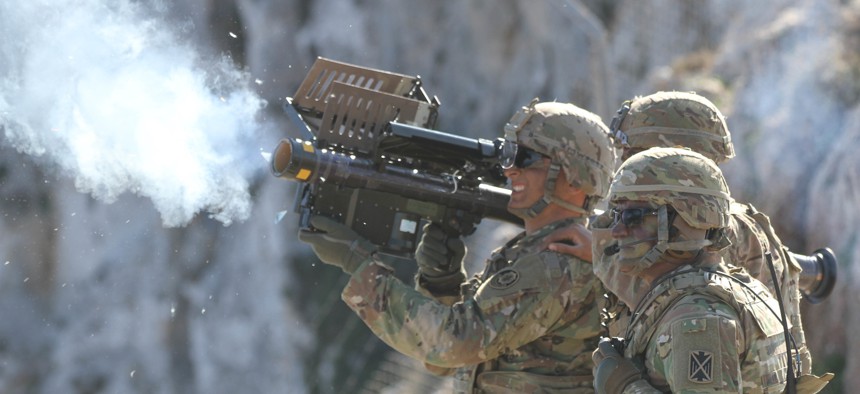
A soldier fires a Stinger missile using Man-Portable Air Defense Systems (MANPADs) during Artemis Strike, a live fire exercise at the NATO Missile Firing Installation (NAMFI) off the coast of Crete, Greece Nov. 6, 2017. U.S. Army photo by Sgt. 1st Class Jason Epperson
How to Save the Pentagon’s Innovation Insurgency
The former chief of the US Army’s Rapid Equipping Force suggests parallel tracks for innovation and execution.
There is an insurgency inside the Defense Department and the intelligence agencies, carried on by passionate, dedicated innovators who survive by skirting the bureaucracies that would grind them down. The good news is that this insurgency of “defense entrepreneurs” is growing, keeping alive America’s hopes for continued military technological superiority. The bad news is that is it doomed to fail — unless we can find a way to harness its work and its spirit within the greater defense establishment.
We must first recognize that our defense and intelligence agencies were built to efficiently and constantly apply resources to ensure the security of our country. The systems that make this possible are not capable of sustaining an innovation ecosystem – nor should they be expected to. In execution organizations, the important metrics concern the efficient use of limited resources. People, vision, culture, and systems are optimized to do more with less. Duplication and redundancy are signs of inefficiency that must be corrected. Failure is to be avoided at all costs. Within such systems, innovation has no seat at the budget table, few resources, and no friendly metrics.
We must also recognize that the innovators are part of the problem. With no common language for innovation and no deliberate means of connecting a myriad of “innovation activities” so that value might move from one to the next, their efforts are often lost. Nor is there an incubation phase that might refine ideas before sending them for execution, which often results in the delivery of immature solutions into a system that is already overburdened just trying to maintain the status quo.
What the defense and intelligence community needs is separate systems for execution and innovation that operate in parallel, with permeable barriers that allow the easy exchange of people, ideas, problems, insights, and solutions. We can start by setting out three goals:
First, these parallel systems must help our defense and intelligence agencies continuously replenish lost capabilities. The rapid advance of technology erodes our advantages at an unprecedented pace. Improvised explosive devices, drones and cyber tools show how often our capabilities attrite even as we deliver them to front-line users.
» Get the best international military business news each week in the Global Business Brief from Marcus Weisgerber. Sign up here.
Second, the new systems must create capabilities to match current and future threats. Today, China is racing to become the world’s artificial intelligence superpower. Other protagonists are perfecting cyber weapons that place our critical infrastructure at risk. Our new systems must simultaneously prepare for the threats that can be anticipated, and quickly pivot to meet the ones that cannot.
Third, we need a vision to shape a national-security culture, organization, processes, and budget that can produce the continuous flow of people, problems, ideas, and technology we require to win wars that have not yet been defined.
Anyone who has spent time in a start-up in Silicon Valley will tell you that their early stages are messy, chaotic, and often prone to violent pivots as their discovery work leads them through the development of a series of minimum viable products. This process of constantly generating hypotheses, testing solutions, and failing is stressful and emotionally draining. To turn an idea into a delivered product requires exceptional passion, a willingness to sacrifice one’s financial stability, and an ability to assemble a team of teams. It is not an environment everyone is suited for.
Yet for all its apparent chaos, this Silicon Valley way generally guides the process and connects different activities to one another, ensuring that only the strongest ideas and companies survive. We must seek to replicate this larger process and the culture it thrives on.
The leaders of the Pentagon and intelligence agencies must issue guidance that supports a disciplined, evidence-based, data-driven process for connecting disparate innovation activities within the government, academia, and industry into an accountable system that delivers solutions to rapidly emerging problems and changes in the environment. Broadly. this system must provide for:
- Putting people, problems, ideas, and technology into an environment where they will collide.
- Figuring out what problems the innovation system should try to solve, and in what order.
- Shaping problem validation, solution discovery, and hypothesis testing with what the intended users say are their standards for mission accomplishment.
- Incubating immature solutions before trying to move them into the execution system.
- Creating an “integration activity” in the execution system that oversees the work necessary to produce a new solution on the required scale.
On the future battlefield, the winner will be determined less by existing technology than by the ability to rapidly recognize a threat or opportunity, assemble the right team to build a pathway to a solution, then move the solution to execution. In an environment where we need to embrace the art of failure, this is the one place we cannot fail.